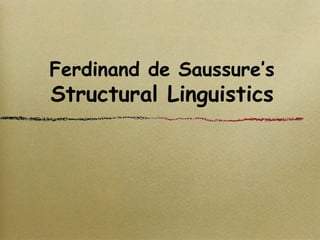
saussure
- 1. Ferdinand de Saussure’s Structural Linguistics
- 2. The idea of language as system of signs is usually associated with Ferdinand de Saussure, a Swiss linguist who lived in the latter part of the 19th century and whose views on language were published posthumously from the lecture notes of his students. For this reason, Ferdinand de Saussure is usually referred to as “The Father of Modern Linguistics”.
- 3. Saussure was a historical linguist who studied the evolution of sound patterns in the Indo- European languages. Historical linguistics in the 19th century and earlier was devoted mainly to find out the proto- type (or mother) languages from which modern languages were thought to have evolved. This devotion to the past was based on empirically- derived premise that some languages evolved from the same ancient language.
- 4. For example, the Indo- European languages like English, German, Sanskrit and Latin share structural similarities, causing theorists to assume that they actually were, at some point in the past, just one language. The same can be said of other families of languages, including the Malayo- Polynesian family to which Philippine Languages belong.
- 6. Saussure came to a point where he became disillusioned with historical linguistics. Saussure abandoned his historical orientation and, instead, set his sights on the system of language itself. In other words, while his earlier works focused on the study of language through time, his new concern dealt with the study of language at a particular point in time. While earlier he worked on the diachronic aspect of language, he now started working on its synchronic dimension. Synchronic (particular point in time) Diachronic (evolutionary)
- 8. According to Saussure, language is a system of signs. A sign functions like a coin with two sides. The first side consists of the form of the sign. The concept of the sign, on the other hand, refers to a mental image which registers in the mind.
- 11. The relation between the signifier and the signified is arbitrary, which means that there is no intrinsic or natural reason why a particular form signifies a particular concept. For example: Teacher Maestro Guro Signifier Signified
- 13. Saussure’s proposition is for us to stick to the study of the abstract system, which is called langue, and disregard the many ways we use the system in real contexts, which are called parole. Parole (individual use of language) Langue (system of knowledge in a society)
- 14. Because Saussure wants us to study language in a systematic, scientific way, it is therefore understandable that his linguistics would focus on the langue, rather than the parole. The langue is abstract and is therefore easily systemized parole is messy, forever changing and therefore extremely difficult to capture in any scientific investigation.
- 16. Aside from the synchronic and diachronic dimensions of the sign, we can approach language through its syntagmatic and paradigmatic aspects. These aspects actually refer to different types of relations that sign can have with one another. On the other hand, sign relate each other in a syntagmatic way- that is according to their positions in a given sentence or utterance. On the other hand, signs relate to each other in a paradigmatic way- that is, according to the membership in particular types or classes of signs.
- 17. Example
- 19. Summary
- 20. • Language, according to Saussure, is a system of arbitrary signs. A signifier and a signified constitute a sign which, in turn, has both synchronic/ diachronic and syntagmatic/ paradigmatic dimentions. • The system is both abstract (langue) and concrete (parole). • Since the goal of linguistics is to look for a system in language in a scientific and empirical way, then the focus of this approach is tha langue of language as well as sign’s synchromatic and syntagmatic dimensions.
- 21. Language as a System Language as a History Language at a point of time Language through time Langue Parole Signifier Signified Form Meaning Synchrony Diachrony Syntagmatic relations Paradigmatic relations Syntactic categories Parameters of choice Present entities Absent entities Idealized language Actualized language Stable Unstable Scientific Unscientific